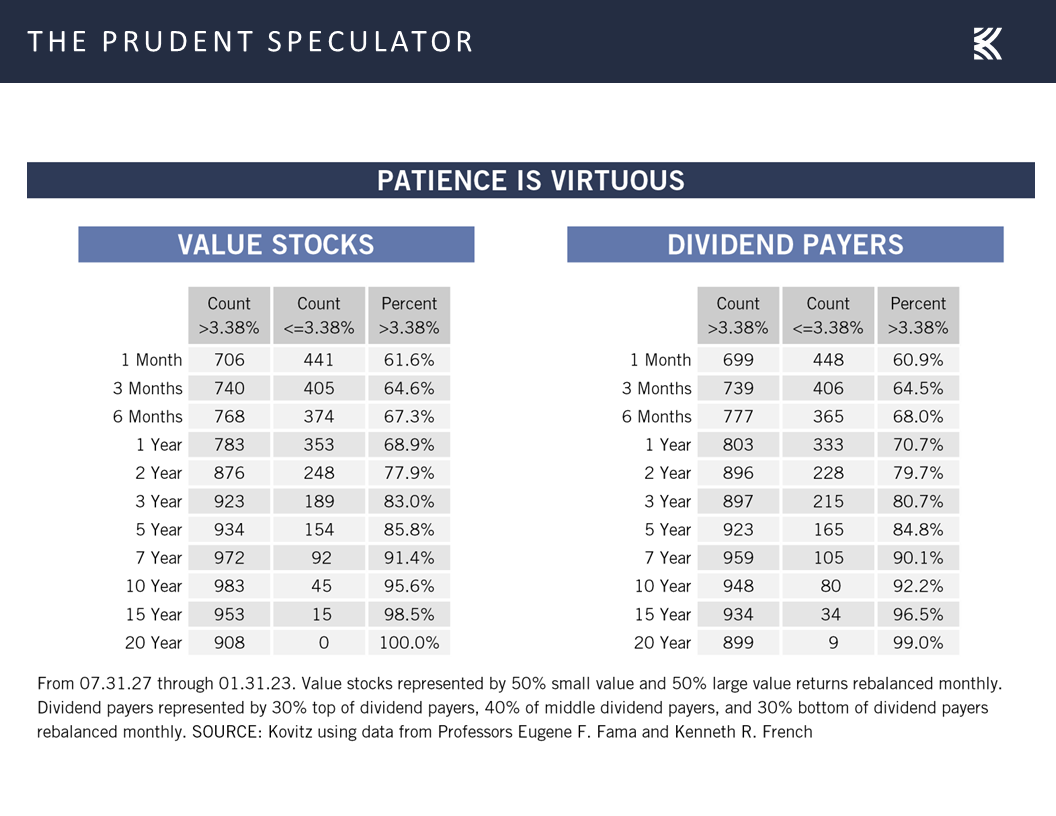The Prudent Speculator Weekly Commentary is expertly curated every week as a valuable resource for stock market news, investing tips, business insights, and economic trends as it relates to value stock investing. This week, we cover Value Stocks, D.C. Fighting Bank Fears, Interest Rates, Fed Projections, Portfolio Valuations and more economic news. We also include a short preview of our specific stock picks for the week; the entire list is available only to our community of loyal subscribers.
Executive Summary
Banking on Value: Special Report on the Banking Crisis
Washington: DC Fighting Bank Fears
Interest Rates: Fixed Income Rally Helping Bank Balance Sheets
Sentiment: AAII Contrarian Buy Signal
Econ News: Data Generally Remain Healthy; S&P Global PMIs Upbeat
FOMC Meeting: 25-Basis-Point Hike & Fed Projections
Earnings: Solid Growth This Year and Next Still the Forecast
Valuations: Still Liking the Metrics for our Portfolios
Patience: The Longer the Hold the Greater the Chance of Success
Stock News: Updates on four stocks across four different sectors
Banking on Value Stocks: Special Report on the Banking Crisis
After the fireworks the prior two weekends, it was relatively quiet this past weekend on the banking crisis front. We recapped developments through Thursday and offered perspective in our latest Special Report, Banking on Value Stocks.
We note, too, that after the close of trading on Friday, the Federal Reserve reported that bank deposits fell by $98.4 billion to $17.5 trillion in the week ended March 15. Deposits at small banks retreated by $120 billion, but those for the 25 largest firms rose almost $67 billion. The latter tally included Silicon Valley Bank, with the combined exodus coming in at a little more than one-half of one percent.
CNBC also reported over the weekend, “The surge of deposits moving from smaller banks to big institutions including JPMorgan Chase and Wells Fargo has slowed to a trickle in recent days, CNBC has learned. The deposit drain, which roiled markets globally and forced regulators to intervene to protect bank customers, began improving around March 16, said people with knowledge of inflows at top banks.”
Washington: DC Fighting Bank Fears
And in more recent news out of Washington, President Biden stated on Friday, “If we find that there’s more instability than appears, we’d be in a position to have the FDIC use the power it has to guarantee those (deposits) above $250,000 like they did already.” In addition, officials at the Financial Stability Oversight Council, meeting in a closed session Friday, insisted the system “remains sound and resilient.”
Further illustrating that point, Secretary of the Treasury Janet L. Yellen had the following to say in prepared remarks on March 21:
Almost two weeks ago, we learned of problems at two banks that could have had significant impacts on the broader banking system and the economy. The situation demanded a swift response. In the days that followed, the federal government delivered just that: decisive and forceful actions to strengthen public confidence in the U.S. banking system and protect the American economy.
Let me be clear: the government’s recent actions have demonstrated our resolute commitment to take the necessary steps to ensure that depositors’ savings and the banking system remain safe.
Our approach had two main pillars.
First, we worked with the Federal Reserve and FDIC to protect all depositors in the resolutions of Silicon Valley Bank and Signature Bank. The steps we took were not focused on aiding specific banks or classes of banks. Our intervention was necessary to protect the broader U.S. banking system. And similar actions could be warranted if smaller institutions suffer deposit runs that pose the risk of contagion. I believe that our actions reduced the risk of further bank failures that would have imposed losses on the Deposit Insurance Fund, which is paid for through fees on insured banks.
Second, we announced a new facility to provide additional liquidity to the banking system. The Fed’s new lending facility – the Bank Term Funding Program – is designed to help banks meet the needs of all of their depositors.
The situation is stabilizing. And the U.S. banking system remains sound. The Fed facility and discount window lending are working as intended to provide liquidity to the banking system. Aggregate deposit outflows from regional banks have stabilized.
As you know, 11 banks – including the very largest and some regional banks – announced $30 billion in deposits into First Republic Bank last week. This support represents a vote of confidence in our banking system.
We are continuing to monitor conditions closely. My team and I have been in close communication with many of you, in addition to federal and state regulators, other market participants, and international counterparts.
While we don’t yet have all the details about the collapse of the two banks, we do know that the recent developments are very different than those of the Global Financial Crisis. Back then, many financial institutions came under stress due to their holdings of subprime assets. We do not see that situation in the banking system today. Our financial system is also significantly stronger than it was 15 years ago. This is in large part due to post-crisis reforms that provided stronger capital standards, among other important improvements.
Interest Rates – Fixed Income Rally Helping Bank Balance Sheets
No doubt, there will be winners and losers in the current crisis, and we cannot rule out additional bank failures. However, as we said in our Special Report, in our view, the potential risks from keeping money on deposit in the domestic banking system continue to be outweighed mightily by the risks and frictions from stuffing bills under the mattress or exchanging for alternative currencies.
We might also point out that the plunge in interest rates with the yield on the 10-Year U.S. Treasury residing today at 3.38%, down from 3.87% at the start of the year,

has bolstered the market for mortgage-backed securities (MBS),

with the price gains in those and other debt securities this year shrinking the unrealized losses for fixed income assets on most bank balance sheets.
Sentiment – AAII Contrarian Buy Signal
Of course, it is puzzling that venture capitalists and private equity leaders in Silicon Valley were willing to hold more than $250,000 in uninsured no-interest or low-interest bank accounts. Ignoring the obvious return of principal risk, the return on principal issue is a head scratcher when bank CDs, money market funds and Treasury bills offer vastly superior yields.
We do not mean to suggest that the banking crisis is only a Wall Street issue or a proverbial fat-cat problem as we respect that cash management is not always possible in business banking. Those on Main Street also are concerned about the safety of their deposits AND the hits that their equity portfolios have taken. After all, the average stock in the broad-based Russell 3000 index has skidded 12.3% since the end of January.
True, the capitalization-weighted market indexes have held up remarkably well, but there has been plenty of damage done beneath the surface. This is part of the reason why fear levels toward equities for the folks at the American Association of Individual Investors (AAII) have remained very high.

Yes, the number of Bulls in the latest weekly Sentiment Survey ticked up to 20.9%, but the tally of Bears rose to 48.9% and the Bull-Bear Spread of minus 28.0% is one of the most pessimistic in the 36-year history of the AAII gauge. Happily, this may not be a bad thing from a contrarian perspective for the prospects of stocks over the next week, month, quarter and six months, on average.
Econ News – Data Generally Remain Healthy; S&P Global PMIs Upbeat
To be sure, the big question for investors these days is what impact the bank upheaval will have on the economy.
Federal Reserve Chair Jerome H. Powell stated on Wednesday, “Since our previous FOMC meeting, economic indicators have generally come in stronger than expected, demonstrating greater momentum in economic activity and inflation.”
Indeed, the forecast as of March 24 from the Atlanta Fed for inflation-adjusted Q1 GDP growth resided at a robust 3.2%,

while the latest numbers on the employment front remained incredibly robust, with first-time filings for jobless benefits below 200,000, a level last seen in the 1960s when the labor market was much smaller.
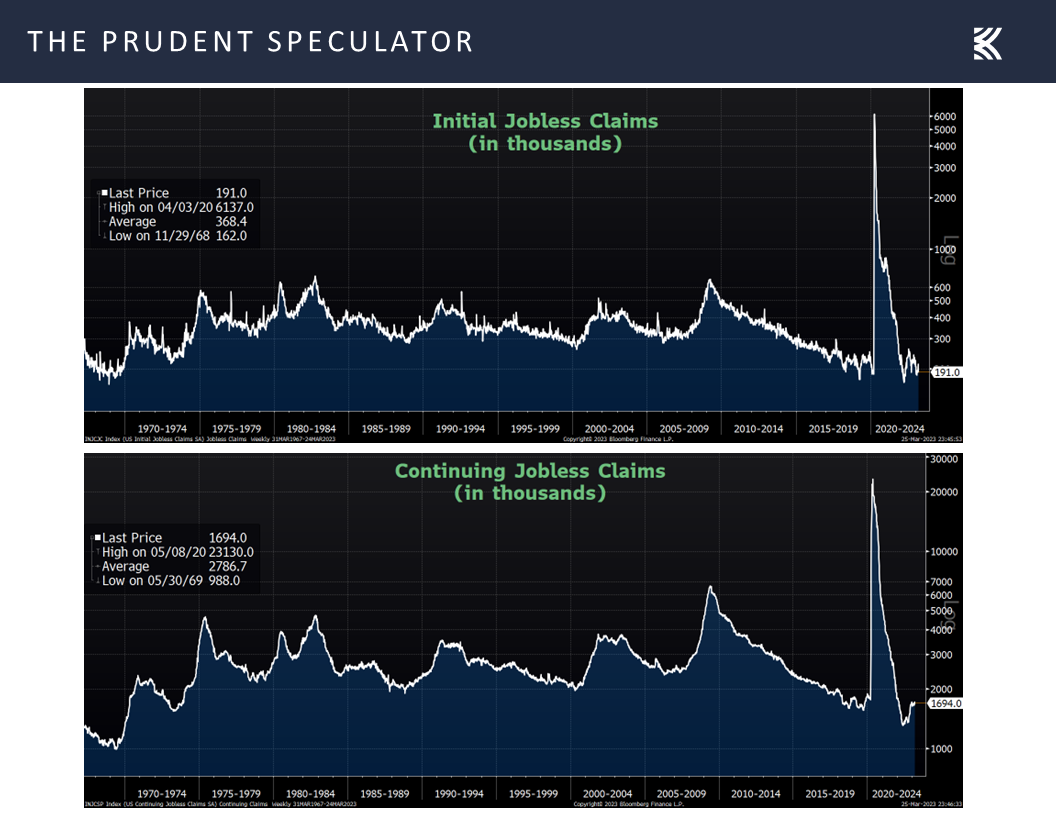
The February counts on existing-home and new-home sales also held up reasonably well, with each seeing improvement over January’s levels.
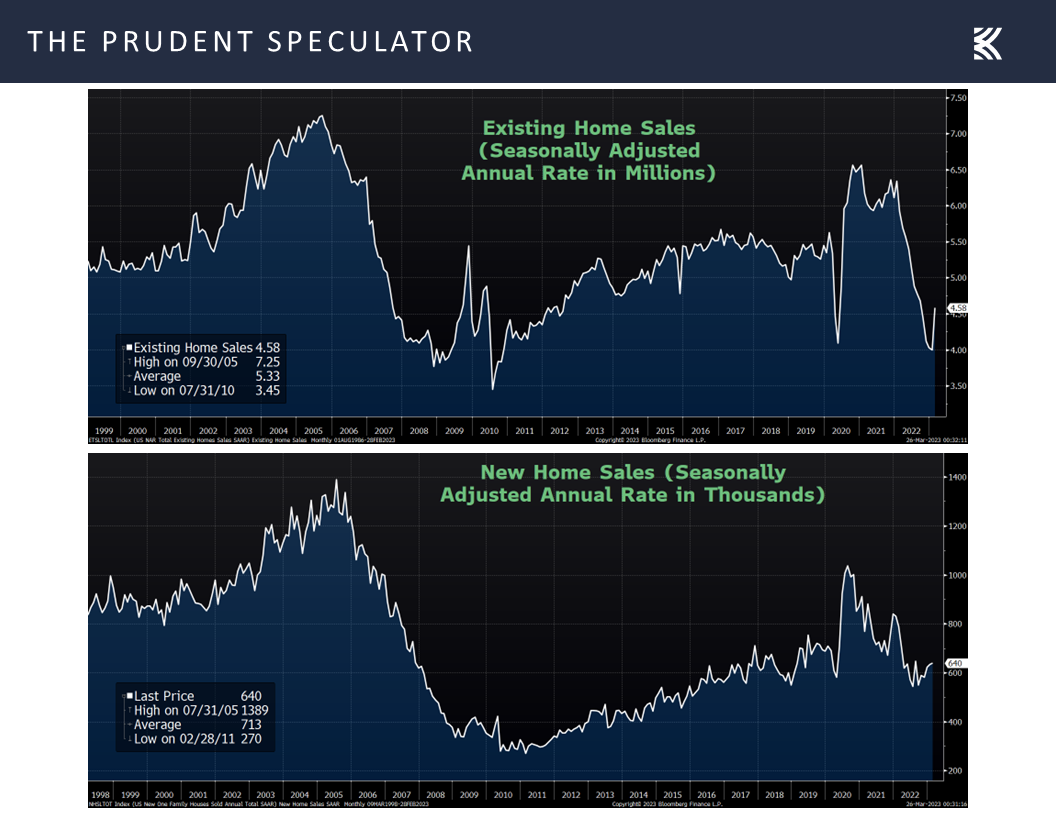
Yes, the 1.0% pullback in durable goods orders for February was worse than expected, due to lower demand for passenger planes and new cars, but business investment rose for the second month in a row, suggesting that factories are likely to keep humming.
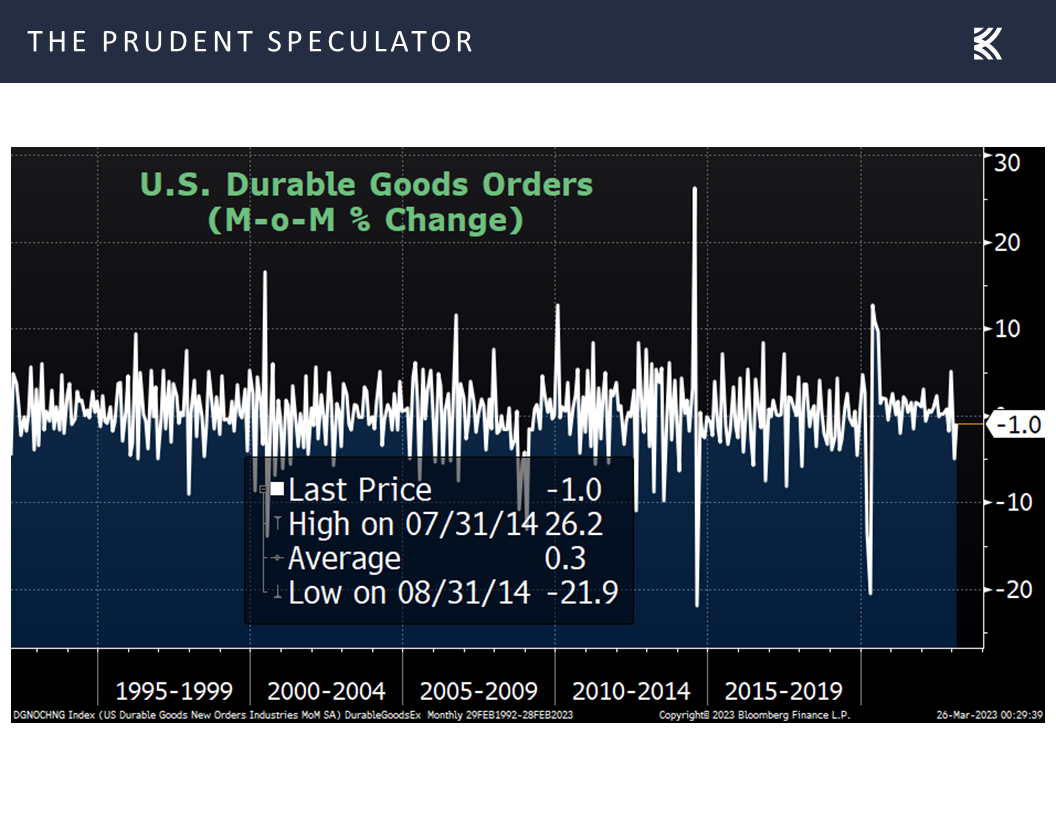
Of course, those last two sets of economic data were from February and Chair Powell reminded, “We believe, however, that events in the banking system over the past two weeks are likely to result in tighter credit conditions for households and businesses, which would in turn affect economic outcomes.”
Still, the forward-looking S&P Global Flash indexes for March came in much better than expected, with the important (it is where most Americans are employed) Services gauge climbing to an 11-month high of 53.8, up from 50.5 in February. The Manufacturing index increased to a five-month high of 49.3, up from 47.3 the month prior. Chris Williamson, Chief Business Economist at S&P Global, stated, “March has so far witnessed an encouraging resurgence of economic growth.”
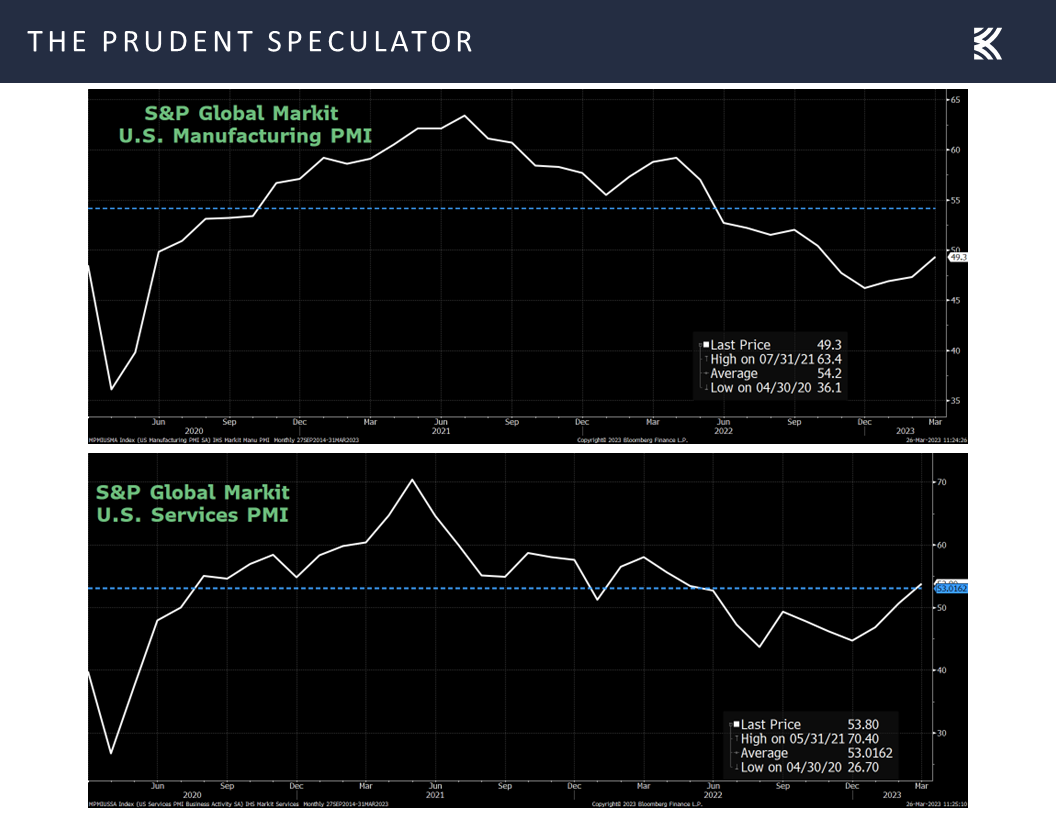
To be fair, Mr. Williamson went on to say, “It will be important to assess the resilience of this demand in the face of the recent tightening of interest rates and the uncertainty caused by the banking sector stress, which so far only seems to have had a modest impact on business growth expectations.”
His comments echoed those of Chair Powell, who said on Wednesday…
It is too soon to determine the extent of these effects and therefore too soon to tell how monetary policy should respond. As a result, we no longer state that we anticipate that ongoing rate increases will be appropriate to quell inflation; instead, we now anticipate that some additional policy firming may be appropriate. We will closely monitor incoming data and carefully assess the actual and expected effects of tighter credit conditions on economic activity, the labor market, and inflation, and our policy decisions will reflect that assessment.
…when he and his colleagues at the Federal Open Market Committee voted to hike their target for the Federal Funds rate by 25 basis points to a range of 4.75% to 5.0%.
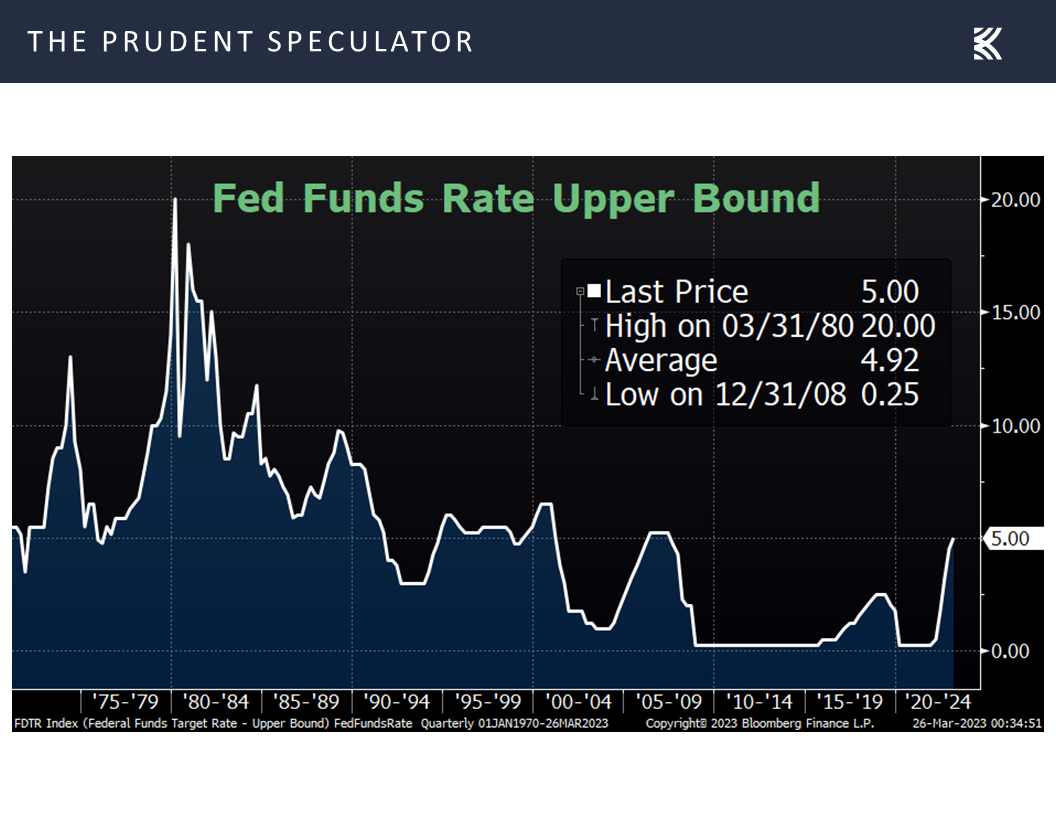
FOMC Meeting – 25-Basis-Point Hike & Fed Projections
The economic projections of the Federal Reserve Board members and Federal Reserve Bank presidents were also updated as is the custom each quarter. While there were no changes in the long-run estimates, the Fed is now expecting a bit slower real GDP growth this year (0.4% vs. 0.5% back in December), a modestly lower unemployment rate (4.5% vs. 4.6%) and a tad higher Core PCE inflation tally (3.6% vs. 3.5%).
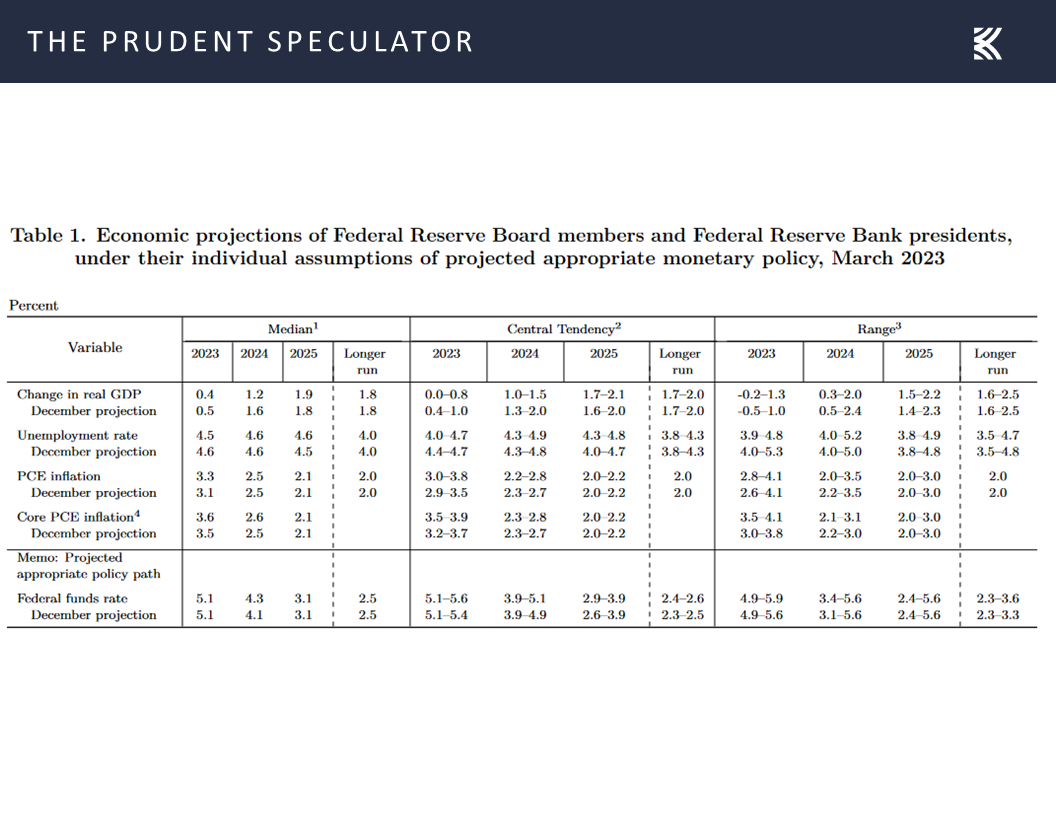
While the Fed is suggesting a year-end Fed Funds rate of 5.1%, the expectation of Fed officials is for a significant decline in interest rates over the next few years,
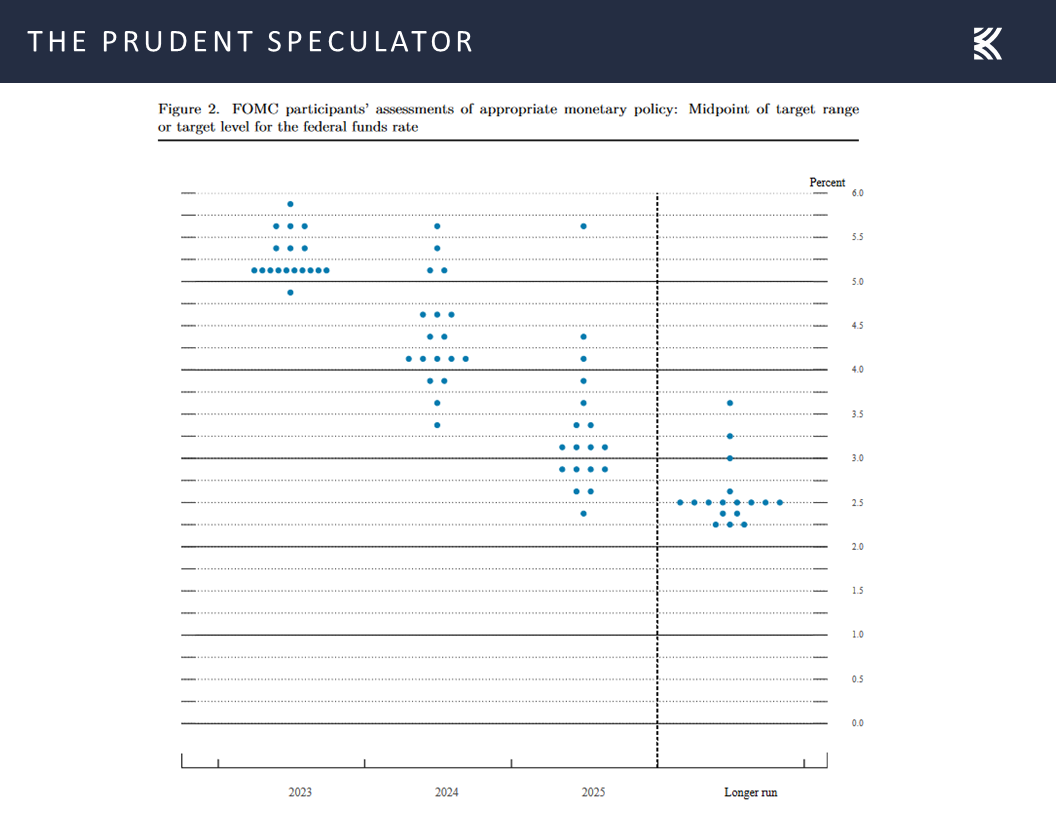
with the Fed Funds futures market presently expecting a quicker pivot from a hawkish to dovish stance for the nation’s central bankers, starting as soon as the June FOMC Meeting.
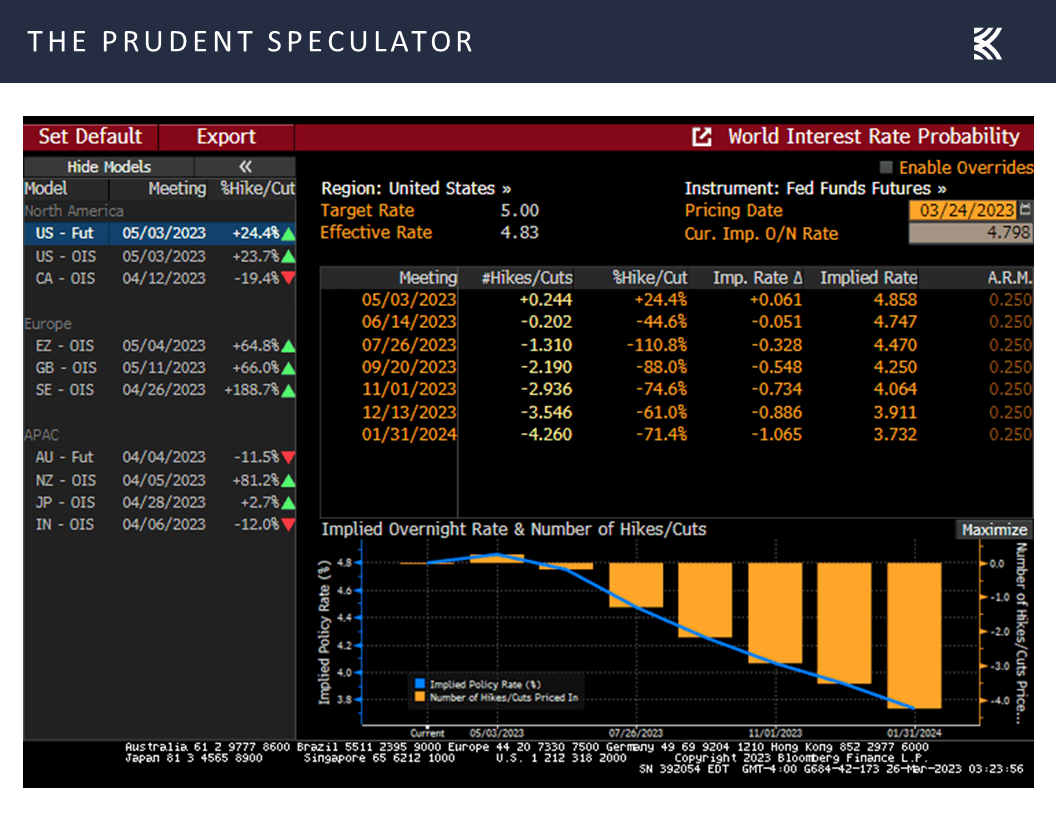
Interestingly, despite the banking crisis, there has been no change over the last couple of weeks in Bloomberg’s calculations of the odds of recession over the next 12 months,
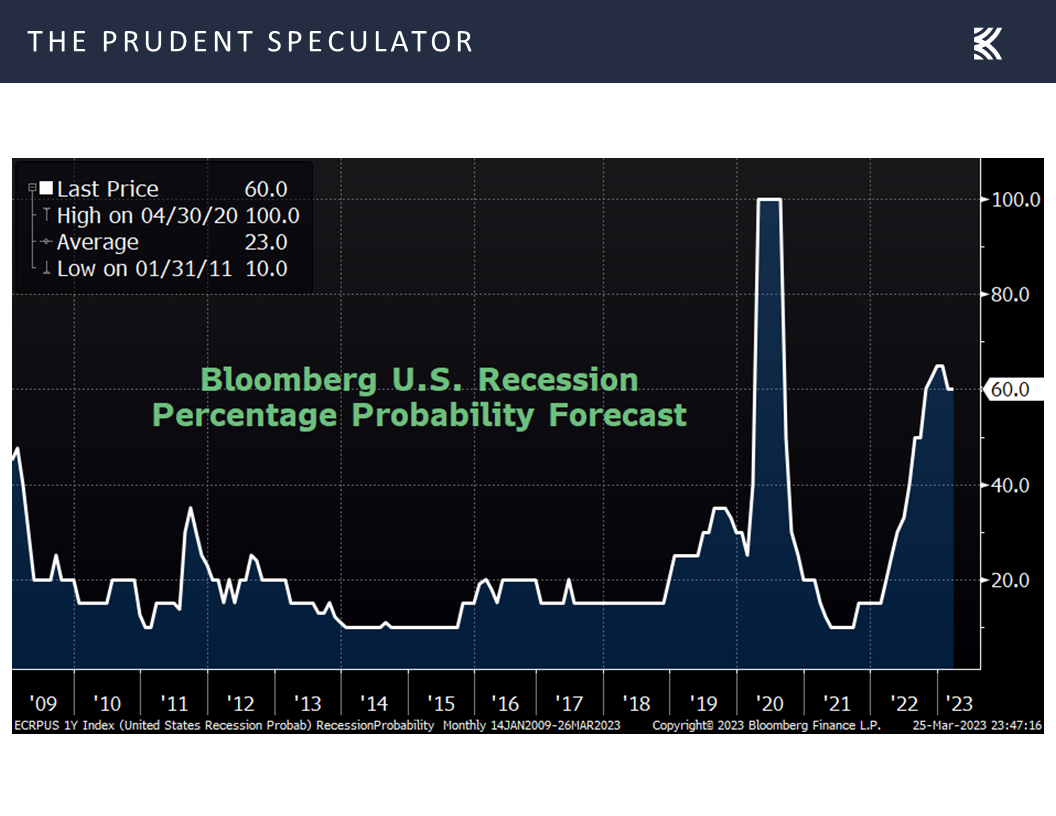
And Mr. Powell said last week when queried on whether he still see a possibility of a soft landing for the U.S. economy:
It’s too early to say really whether these events have had much of an effect. It’s hard for me to see how they would have helped the possibility but I guess I would just say, it’s too early to say whether there really have been changes in that. The question will be, how long this period is sustained. The longer it’s sustained, then the greater will be the likely declines in tightening credit standards, credit availability, so we’ll just have to see. I do still think though that there’s a pathway to that. I think that pathway still exists and we’re certainly trying to find it.
Earnings – Solid Growth This Year and Next Still the Forecast
As the saying goes economists have predicted nine of the last five recessions, so we are not losing sleep over the risk of recession, especially given that we are investing with a long-term, three-to-five-year-plus time horizon. Certainly, there have been some big downturns associated with economic contractions in the past, but we like what history has to say, on average, for recessions and returns on Value Stocks
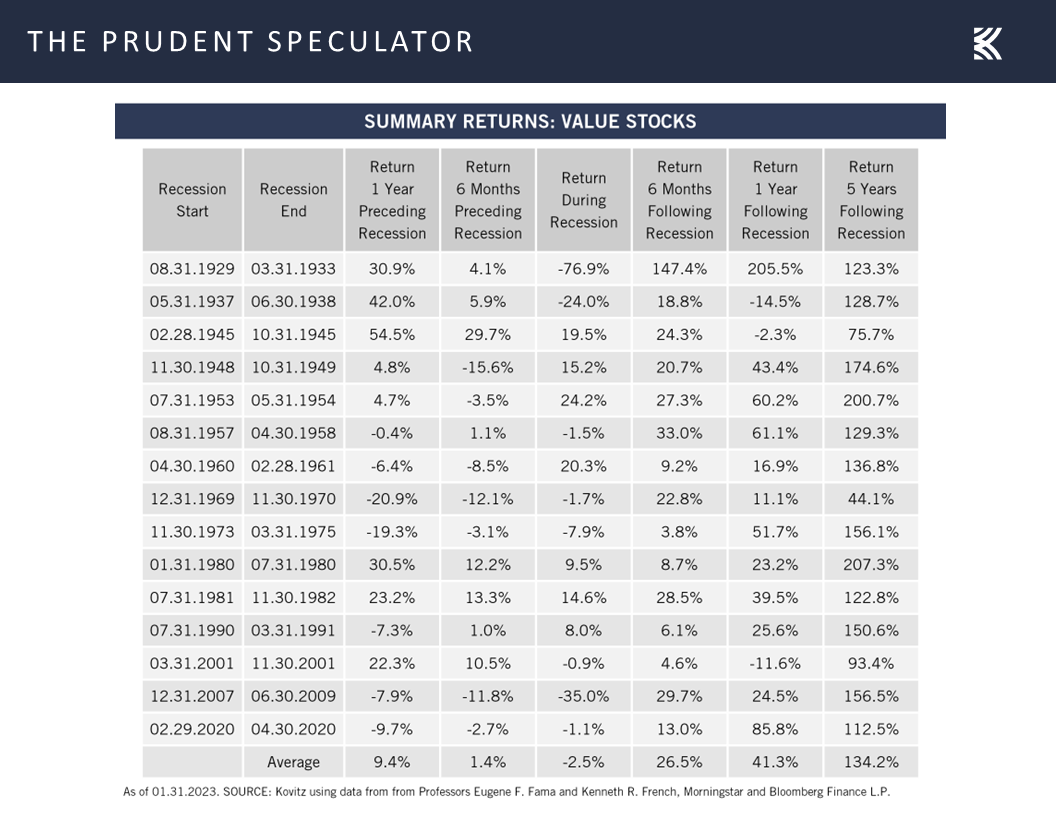
and Dividend Payers.
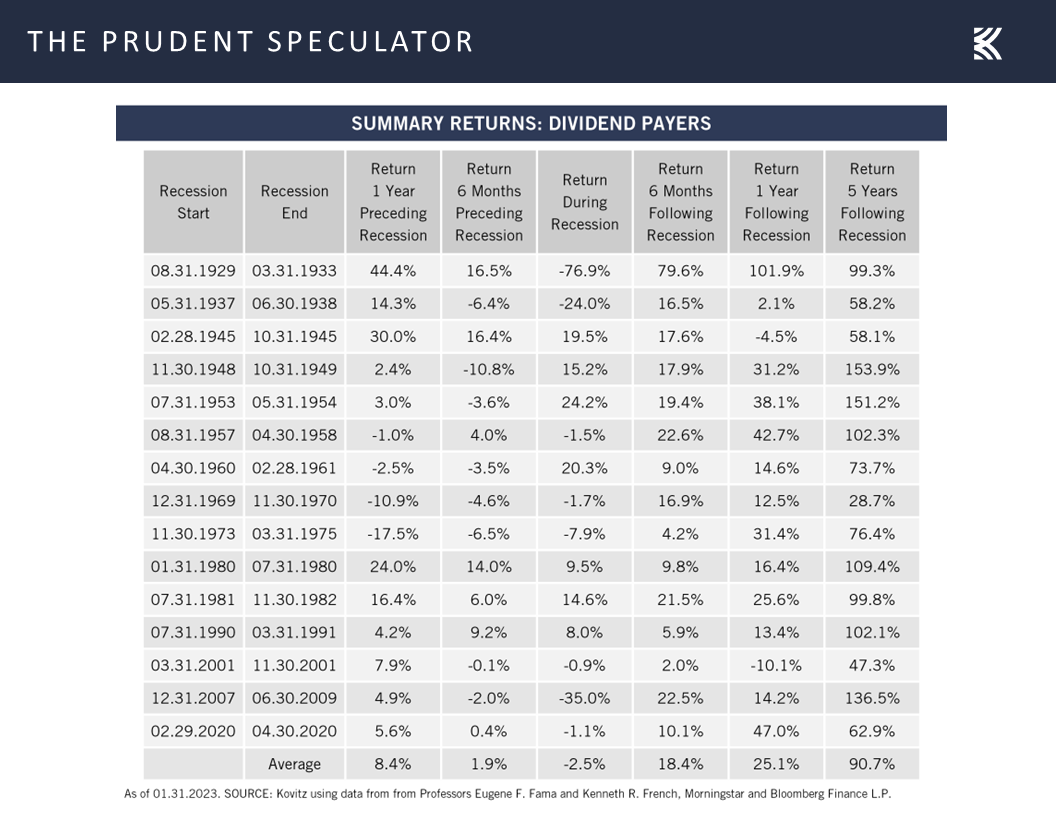
Analysts are often overly rosy in their estimates, but even many of the economic pessimists are thinking that a recession this year would be mild, with corporate profits likely to remain healthy.
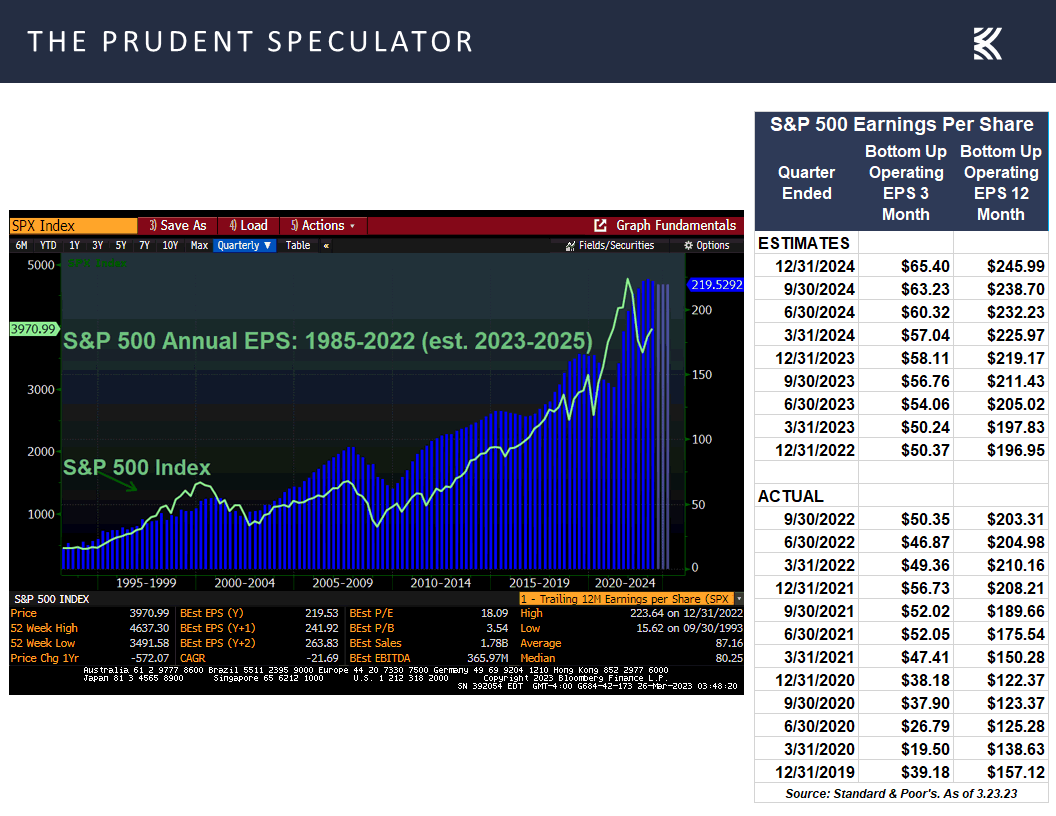
Valuations – Still Liking the Metrics for our Portfolios
Certainly, we realize that anything can happen in the near-term, but we continue to like how the metrics (very reasonable multiples of earnings and generous dividend yields) look on our broadly diversified portfolios of what we believe to be undervalued stocks,
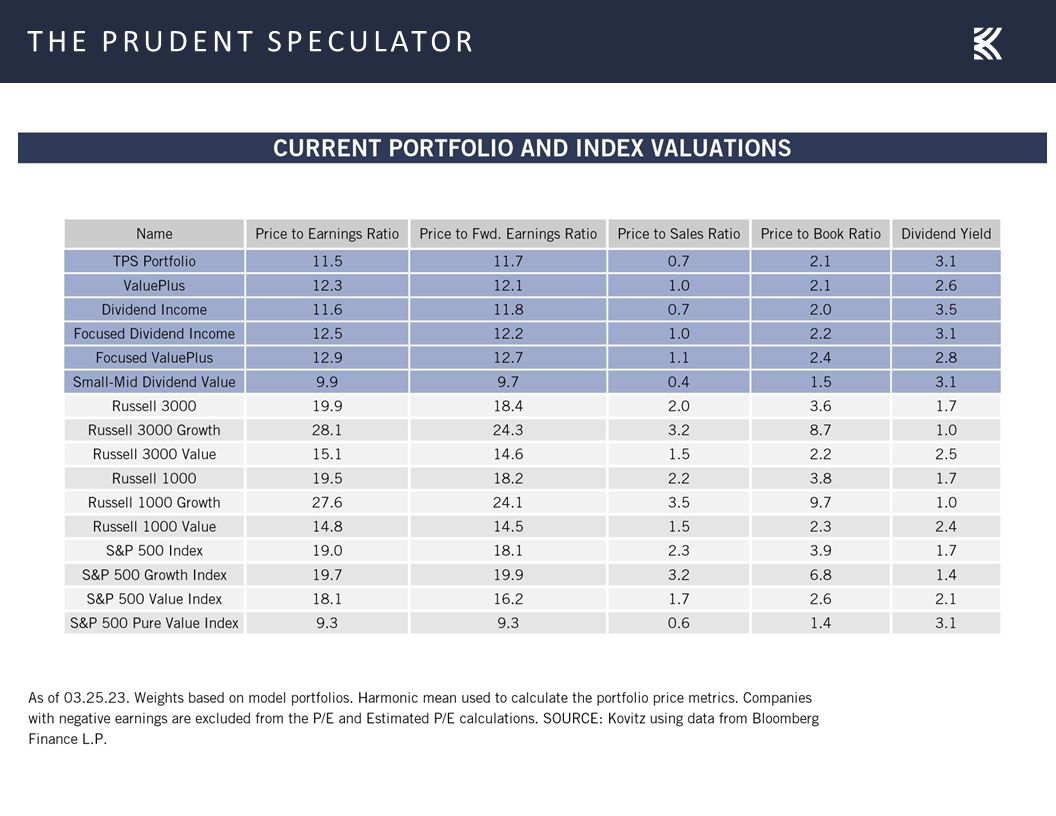
Patience – The Longer the Hold the Greater the Chance of Success
while history shows that handsome rewards generally have accrued to those who can hold their stocks through thick and thin. Indeed, 69% to 70% of the 12-month holding periods for Value Stocks and Dividend Payers show annualized returns above the current 3.38% yield on the 10-year U.S. Treasury, while the equity “success” rate moves up to 85% to 86% for five-year periods and to 92% to 96% for 10-year periods.
